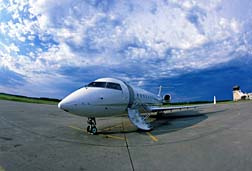 It was this past Friday at Columbia Metropolitan Airport in South Carolina that a Learjet 60 carrying DJ Adam Goldstein, rock drummer Travis Barker and Barker's 2 assistants ran off the runway and crashed hard, killing the pilot, co-pilot and the two assistants. Barker and Goldstein survived, but were injured in the crash.
It was this past Friday at Columbia Metropolitan Airport in South Carolina that a Learjet 60 carrying DJ Adam Goldstein, rock drummer Travis Barker and Barker's 2 assistants ran off the runway and crashed hard, killing the pilot, co-pilot and the two assistants. Barker and Goldstein survived, but were injured in the crash.The unique aspect of this plane crash is that the Learjet never left the ground. It appears as if a blown tire may have set the wheels in motion, if you will, for the failure of the plane to take off at all. However, why the plane actually crashed is subject to some conjecture and further investigation.
According to reports, the flight crew reported hearing what they thought was a blown tire, seconds before communicating to controllers at the airport that the jet was running out of runway.
Were that to be the case, it sets off a series of events and questions surrounding protocol as to just what is supposed to happen when a plane loses a tire prior to takeoff.
According to recommendations contained in Federal Aviation Administration (FAA) guidelines, "if a tire failure is suspected at relatively low speeds, it should be treated the same as any other rejected failure and the takeoff should be rejected promptly.
"Rejecting a takeoff from high speeds with a failed tire is a much riskier proposition," the advisory goes on to say. "The chances of an overrun are increased simply due to the loss of braking force from one wheel…
"In this case, it is generally better to continue the takeoff."
The aforementioned training advisory was applicable to pilot Sarah Lemmon and co-pilot James Bland, who both held 'transport' certificates, and who were both killed in the crash.
A spokesperson for the National Transportation Safety Board (NTSB) described the crash as a "high-speed overrun," which suggests, pending further investigation, that the pilot might have been better to take off and deal with the lost wheel upon landing, than attempting to abort the take-off. The protocol advises that it is easier to take off and land later with a blown tire mainly because "the entire runway will be available for the stop maneuver."
At Columbia Metropolitan Airport, the runway used by the doomed Learjet measured 8,602 feet. Reports indicate that the suspected blowout occurred as the aircraft reached 92 mph. Investigators report finding the first tire fragments at the 2,800-foot mark. If such a finding suggests that the blowout occurred there, that would have left the plane 5,800 feet to attempt a stop.
It is unclear why the plane wasn't able to stop in that distance.
Experts familiar with aviation and that type of plane have suggested that even at that speed, the Learjet should have had sufficient room left on the runway to safely stop. However, the fact that the flight crew failed to do so, leads one to believe that either an equipment malfunction prevented the pilot and co-pilot from stopping the plane, or that they simply waited too long to try to abort the takeoff. The latter would suggest indecision, and pilot error.
READ MORE PLANE CRASH LEGAL NEWS
It has been suggested that a tire blowout could have had the same effect on the squat switch on the Learjet 60, which crashed Friday.
The investigation continues. In the meantime, the families of those killed and injured will be watching carefully from the sidelines for a cause that may dictate possible court action, together with the reminder that a plane can crash without having ever left the ground…
